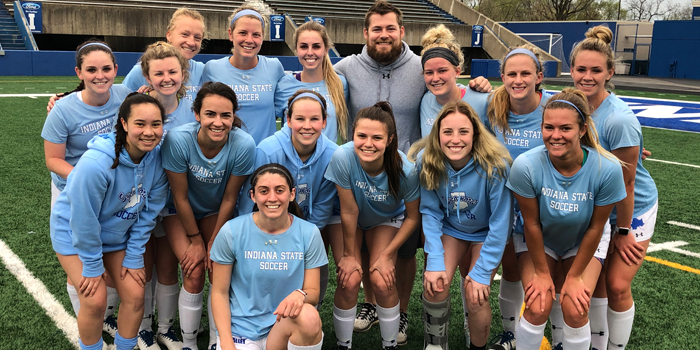
Acknowledgments
Before I dive headfirst into this article, there are several individuals who need to be recognized for their contributions both in my understanding of the conjugate system and my development as a coach.
Any time the conjugate system is mentioned, you must give Louie Simmons credit. His contributions to strength can never be celebrated enough.
I also have to thank Nate Harvey for taking the time to put his experiences running this system at the collegiate level on paper for everyone to see.
RELATED: The ABCs of My Life in Strength, Conditioning, and Fitness
But because reading and gathering knowledge isn’t enough, I have to thank Brandon Smitley for helping me understand this system and how to implement it. Our conversations about strength have had a huge influence on me, and I cannot thank him enough. If you’re in the Terre Haute, Indiana, area, you need to stop by THIRST to train.
I’ve been extremely privileged to have spent time under some of the finest collegiate strength and conditioning coaches in the field. My mentors span a number of schools, conferences, and sports, from the University of Florida, New Mexico State University, The University of Texas, Ole Miss, The University of Virginia, and Indiana State University. I cannot thank you all enough for giving so much of yourselves so that I can have the opportunity that I do right now. I’m forever indebted to you.
“It’s easy to see the light when standing on the shoulders of giants.” — Louie Simmons
How I Arrived at This Point in My Career
All of 2018 seemed to be a rollercoaster of opportunities and emotions. I was nearing the end of my time at New Mexico State University. Having come incredibly close to two full-time jobs (one of those being at a major FBS school), I was left wondering where my career was going and what else I was meant to find on my journey through strength. Knowing I needed to earn my master’s degree, I applied to an open graduate assistant position at Indiana State University in June 2018.
Coach McMannus gave me the nod, and back to Indiana I went. My coaching toolbox was loaded with all sorts of experiences and pieces of information I could draw from the incredible staffs at Mississippi State and New Mexico State University when needed. If I didn’t have the experiences I had at both places, I would not be as well prepared as I am now.
If there’s one thing I know for sure, it’s that I’ll never have all of the answers as a strength coach. I knew there was something else I was meant to find and become entrenched in at Indiana State. It took about two months into my first semester to link up with a few classmates that trained at Terre Haute Intensity, Resistance and Sports Training, otherwise known as THIRST. I had known about the gym before I moved here. A good friend of mine from undergrad had told me about the facility, and that I needed to take a trip there and link up with Brandon Smitley.
After taking an invitation to squat one Friday evening, I knew right away that if I wanted to not only take my training to the next level but also my coaching, I needed to constantly be in that environment. Once I was there, I became compelled to train for my first powerlifting meet. I had talked to Brandon several times about the conjugate system and how he would implement it with a newcomer. The more we talked, the better I understood the system and decided to give it a go with my own training.
While my numbers weren’t anything impressive, I had a blast at the January 2019 meet hosted by THIRST, but more importantly, I noticed how awesome my body felt during training. For the first time in about six to seven years, I was creeping closer to numbers I hadn’t touched since undergrad, but more importantly, I was healthy. I knew that there was quite a bit of low-hanging fruit that I was well within reach of, and that this system would help the athletes I coach when intelligently implemented.
The Program
I developed a nine-week cycle that I felt, at the time, could help our women’s soccer program. I had asked to coach them at the start of the 2019 spring semester, and once the green light was given, I went straight to the whiteboard. Here’s a brief summary for both initial max effort and initial dynamic effort.
My thought process on this was simple. Work to a 5RM on Week 1; 3RM on Week 2; and then a heavy single on Week 3; and then rotate barbells and lift variations. I kept the accessory volume low to moderate on these days.
For our dynamic work, I kept things simple. Working between 40 to 45 percent, I increased the volume over each three-week wave. The girls were paired up two to a rack, which allowed for a “you-go, I-go” tempo, which timed out between 45 to 60 seconds between sets. Wave 1 was 8 sets; Wave 2 was 10 sets; and Wave 3 was 12 sets. These are the days where our accessory work was on the higher side.
All squatting was done to a parallel box with a two-second pause, and all pressing was touch-and-go. The Micro bands gave us approximately 50 pounds of tension, and the Mini bands gave us approximately 100 pounds of tension.
Nothing Goes According to Plan
While this looked like a good plan on paper, I found out quickly that I had to account for a few variables I hadn’t considered:
- Spring season
- Athlete height
- Band tension
- Bench numbers
- Familiarity with lifts
First, the hectic spring season load was something I did not account for. However, the cycle layout on the squat lined up pretty well. We had three weeks to cover as much ground as we could on the Safety Squat Bar box squat, and then during the spring season transition into the front squat to a box.
My thought on this was that we could get some decent strength built in the first three weeks with the Safety Squat Bar, and during the spring season, the front squat would force the loads to be much lighter, so fatigue accumulation via squatting would be kept to a minimum.
Second, I quickly found that the height of the athlete matters when setting up bands. To maximize band tension for our group, I decided to go with a doubled-over Micro band for the first wave instead of Minis on both the bench and the squat. We were able to keep constant tension on the bands and still move the weight as fast as possible across the board. Once the group’s strength and proficiency for squatting with band tension increased, we moved to a doubled Mini band for the final two waves for the squat. We stuck with the doubled Micro bands for the bench.
Dynamic effort percentages on the bench press had to be shifted around. If I stuck with 40 to 45 percent, several girls would be prescribed weight that was either the bar alone or lighter than the bar. An easy fix was to go between 50 to 55 percent. That way we had weight on the bar with our bands, but at the same time, bar speed was not compromised for the sake of having the barbell loaded.
Lastly, I made the decision to alter my max effort bench wave a little bit. Instead of starting with the multi-grip bars, I went with a normal flat barbell bench press. My thought there was to have some degree of familiarity in training, especially on the first day with a new strength coach and a new program to run.
Here's What Actually Happened
What About the Olympic Lifts?
Since I became a coach, I’ve always prescribed Olympic lifts for my teams. I feel that I can implement and coach them at a high level that is both safe and effective. There are programs that are Olympic lifting-heavy and other programs that don’t do a single one. Neither program is better or worse than the other; each one has its own methods and reasons as to why or why not it should be implemented.
For this particular team, I opted not to take the time to implement the Olympic lifts. Instead, I relied on weighted and un-weighted box jumps for our primary means of triple extension. When I start my implementation of the Olympic lifts, I start with the clean via a simple barbell complex.
After the first few workouts of watching the barbell complex, I started to shift my thought process. To get this lift implemented safely and effectively, it would take quite a bit of time that I didn’t necessarily have. With what I was doing with this team and where I wanted to see our training go, I opted to use the small amount of time I did have on pushing the bench press and the squat.
Accessory Movements
Taking a page from Conjugate U, I split my accessory lifts into their own lanes. Below is how I divided up my accessory movements:
What We Found
Coming into the spring semester training, the numbers I had from previous testing were from November 2018, and everything was a 3RM, so I equated it to 90 percent and found their maxes from that data. Here is what we got from training:
- Every athlete went above their calculated 1RM on both the Safety Squat Bar box squat and the bench press at the end of the first three-week wave.
- Eight girls squatted 200 pounds or better on the safety bar to a parallel box.
- For the first time in our head coach’s time at Indiana State, the entire roster passed their fitness test before the start of the spring season. We did zero conditioning outside of morning practice sessions. This was accomplished during Week 4 of training.
- Several girls beat their previous flat bench PRs on the multi-grip bars during our second three-week wave at the Week 6 mark.
- By the end of the second three-week wave, all but two athletes were able to do a set of five on bodyweight neutral grip chins. In the beginning, only one athlete could accomplish this.
- With a small roster of 17 athletes, everyone made it out of the spring season with no major injuries.
- At the conclusion of testing, every athlete hit PRs on both the squat and the bench while meeting the requirements to pass all pre-hab testing for the shoulder and hamstring.
What I Would Do Differently
After looking at what we were able to accomplish during the 2019 spring semester at Indiana State, there are a few things I would have done differently if I could go back and do it all over again.
- First, I would have programmed back-down sets on ME lower days. This being my first time working with a soccer program and it being a new exposure to the girls, I opted to work up to our heaviest set of the day and get the rest of the volume from our auxiliary movements. Once I made the decision to pull away from the boxes on ME days for Weeks 10 and 11, the feedback I got from the girls was that their adductors/groins were a little more sore than usual. Watching them squat without a box was interesting. You could see that they were trying to find the proper depth I was looking for, but once that position was found, the lift was executed at a high level.
- Along with programming back-down sets on ME lower days, I would take away the box for those sets. That way the girls could have immediate feedback between the two movements, and things would make more sense when it came time to test at the end of the training cycle.
- Instead of using the incline bench press as the main movement, I would have opted for the floor press instead. The feedback that comes from the floor is as close to benching on a wide bench as I could get in our facility.
- Another adjustment I would make would be adding slightly more volume on ME upper and lower days. Early on, I wanted to get an idea of what the girls could recover from in enough time to have success on our DE days. I decided to stay on the conservative side, and as the semester progressed, our girls could handle more volume, which was impressive given the load they had to deal with while being in a spring season.
Why I Wrote This
READ MORE: Here's How You Can Land a Collegiate Scholarship for Powerlifting
Along with spending the last several years under some awesome coaches, I find tremendous value in resources such as elitefts. We all get better as coaches by sharing our experiences, what worked, what didn’t, and what we would do differently. This is an opportunity for me to share my experiences as a coach in the hopes that it may help someone else, and at the same time, receive some feedback from coaches who will know more about this system than I’ll ever know. If anyone wants to reach out and connect, I’m on Instagram @strength_coach_white, Twitter @SCCoachWhite, and my email is lucas.white@sjsu.edu. Thanks for reading!
Lucas White is in his fifth year as a collegiate strength and conditioning coach, and in his first year as an assistant strength and conditioning coach at San Jose State University, where he works with football, track and field, both men’s and women’s soccer, and assists with baseball. He was a graduate assistant at Indiana State. Lucas was also on staff at New Mexico State University from August 2016 to July 2018, where he worked with football, baseball, softball, men’s basketball, cross country, and track and field. Lucas holds credentials from the NSCA and the CSCCa as well as a bachelor’s degree in kinesiology from the University of Southern Indiana. He’s currently pursuing a master’s degree in physical education and coaching at Indiana State University.










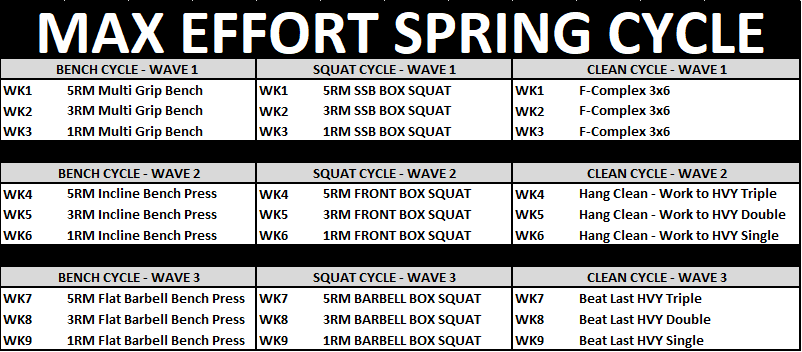
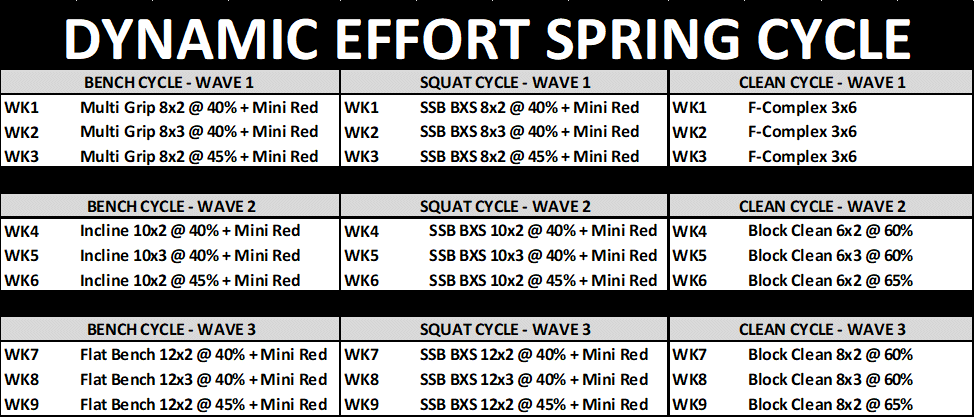
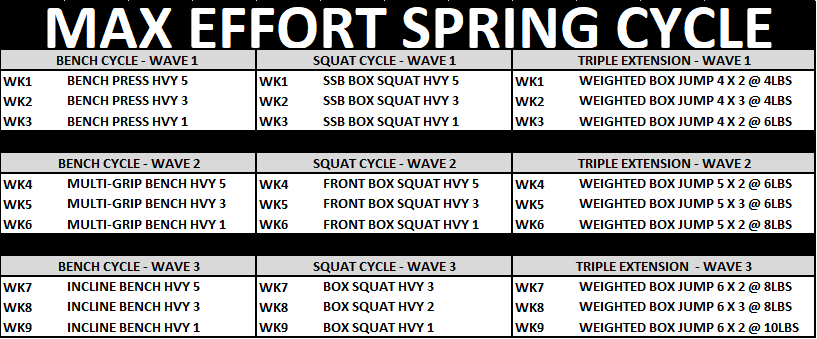
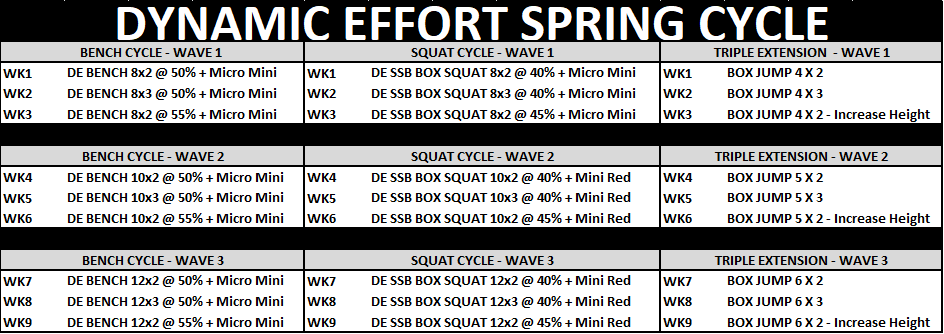


Monday - ME Upper
Tuesday - ME Lower
Wednesday - Off
Thursday - DE/RE Upper (Throws for DE)
Friday - DE/RE Lower (Jumps for DE)
Hopefully that helps! If you want to get in contact with me, I put my social media handles and my email address on the end of the article! Feel free to reach out anytime!